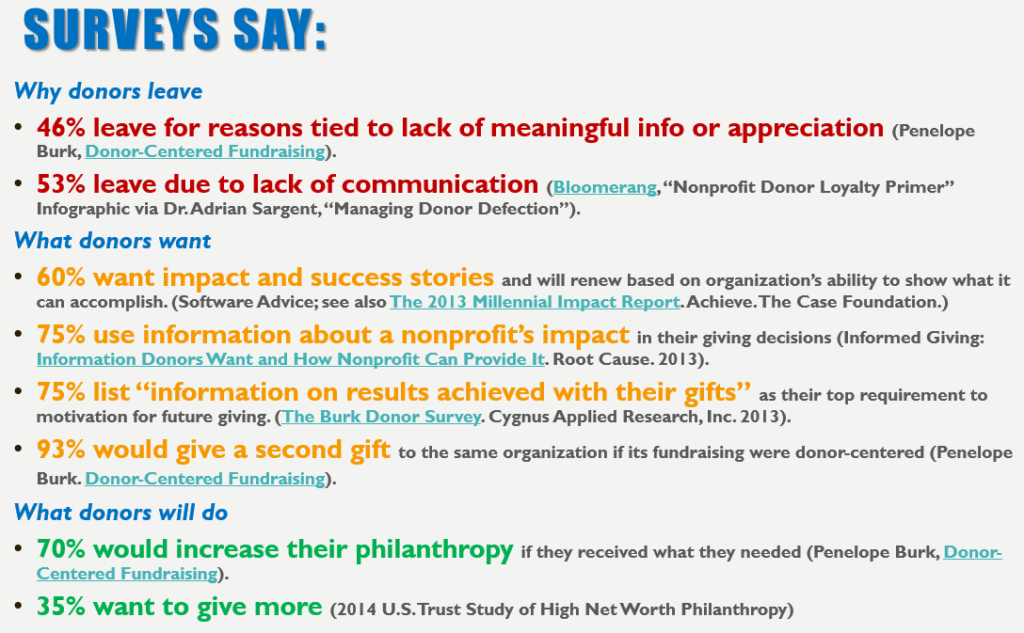
Are you on a fundraising treadmill, getting nowhere?
Are you caught in the trap of transactional fundraising?
Donors come in. Donors go out.
One-time gifts are here today, gone tomorrow.
It’s like being on a non-stop treadmill. Just exhausting!
There’s a way to catch your breath, and even begin to enjoy breathing again.
Instead of continuing on as a transactional fundraiser, become a donor experience transformist!
Receipt of the gift is the beginning, not the end.
Before you can create a transformative donor experience, you must undergo a transformation of how you think about donor acquisition and retention. If your holy grail is simply getting the gift, you’re missing the point.
Your holy grail should be building the relationship, so you’ll achieve donor loyalty.
Otherwise, you’ll miss out on the long-term value of every donor you bring in.
Sadly, absent cultivation most donors will fade away. According to the Fundraising Effectiveness Project, average new donor retention is 20%. You keep just one in five! Ongoing donor retention is just 45%. You can keep trying to fill your funding bucket up to less than half of capacity every year until the end of time. It still won’t be enough to nourish your cause.
It’s downright depressing. But… there’s a fix.
If you can retain a donor even once, the average subsequent retention rate goes up to 61%. A huge increase!
And it’s totally within your control.
Fill your donor’s cup with joy!
If you communicate only once or twice before asking for a second gift, your donor’s cup will feel half empty. Their warm glow will evaporate – unless you focus on filling their cup to the brim.
In fact, direct mail guru Tom Ahern suggests you don’t even consider a first-time giver a “donor.” Rather, look at the first gift as the gift of attention. They’re letting you know they’re inclined to become a regular donor, but not until you show you’re worthy.
You show you’re worthy of further attention when you deliver donor love.
The joy that comes from giving won’t last unless you continue to communicate with your donor over time and pay greater attention to cultivation. Donors tell us as much over and over again, It’s the old “out of sight, out of mind” axiom in action.

Donors are practically screaming “Give us what we need!” “Help us!” “Delight us!” “Don’t treat us like ATMs!” “Engage us!” “Demonstrate our impact!” “Show us you know us!”
Build a Happiness Delivery Plan
It’s the job of the fundraiser to nip any donor screaming in the bud.
Make your donor feel good every way you can, online and offline. It’s best to use a mix of delivery channels because you often won’t know where your donor hangs out and pays attention. Put your eggs in different baskets so your donor is likely to discover something somewhere that delights them!
Every step of the way think:
- “Will this (tweet) make my donor happy?”
- “Will this (email) bring them emotional satisfaction?”
- “Will this (video) spark joy?”
If yes, great! If not, back to the drawing board.
Consider these elements of your Happiness Delivery Plan:
1. Prompt, personal, relevant thank you.
This should be purely a thank you. Something that makes your donor feel valued… gives them a warm glow… and begins the transformation from one transactional gift to a budding relationship. No impersonal receipt. No report. No brochure. No ask.
- Get it out in 48 hours.
- Use their correctly spelled name; no “Dear Friend.”
- Assure the letter relates back to the campaign to which they responded; mention the purpose for which they donated.
- Make it all about the donor, not about you/your organization.
- Be sure it doesn’t appear to be another fundraising appeal. Avoid “the need is still so great.” Eschew data. Stay away from your process.
- Stick with specific, heartwarming, inspiring impact.
- Be sure to give the donor credit for creating that impact.
- Add a personal handwritten note.
- Give contact information; let them know you’re there to help.
2. Welcome package.
Warmly invite first-time donors to join your family. Nothing expensive. Just notice they’re new, and let them know some ways they can become involved that don’t involve making another monetary gift. Not yet.
3. Token gift.
If you want gifts, you must give them. You can include inexpensive tokens in your thank you, welcome package or simply as random acts of donor kindness. [Check out 72 Creative Ways to Thank Your Donors.]
Content is also a gift, so if you primarily communicate with donors through a newsletter or blog, don’t leave the content entirely up to your marketing staff. Too often, marketing staff think about branding, sales, and what the organization wants to tell constituents – rather than what donors want to hear. Donors want less lecture, more love. It’s your role to think from the donor’s perspective. Offer:
- Stories of impact.
- Useful content such as “how to tips,” white papers, recommendations, expert advice, etc.
- Fun, relatable content like jokes, entertaining pictures, recipes, inspirational quotes, etc.
4. Emotional experience.
How do you leave your donors feeling after they interact with you? The Temkin Group, which specializes in customer loyalty in the commercial sector, found positive emotions drive loyalty. The top three emotions? Excited, appreciated and happy. The bottom? Disappointed and frustrated.
Know that giving is not always its own reward. What if you received the same thank you letter from your nephew every year after his birthday? “Thanks for the gift.” No mention of what it was, how they plan to use it, that you’d given a special gift this year in honor of their “big” birthday, that you’d given it for a specific purpose (to use on your upcoming family vacation), and how it was exactly what they needed. You know only they received it; you get no rewarding emotional pay-off. You feel disappointed. Frustrated. That’s what it’s like for your donor most of the time. Unless you…
Show up, virtually, and call your donor out as your hero! Demonstrate repeatedly how you’re using their gift. Per research, our emotional systems like newness. If donors don’t hear back from you until the next time you ask for a gift, they’ll likely forget about you. Maybe they’ll renew. Maybe not. They’re certainly unlikely to give more.
Seeing is believing. So take donors on field trips. Create hands-on volunteer activities just for them. Bring clients in to talk at meetings and events. Read thank you notes from clients to them, or slip a few into their thank you letters. Invite them to write letters to the editor or offer testimonials at community meetings. Make donors the voice of your organization, and let the experience really sink in.
Summary
The key to effective donor cultivation is to emotionally move your donor. Make donor cultivation about recognition and praise. Make your donor feel they mean more to you than they even thought they did.
This is what will make your donor happy. And it’s the only way you’ll turn an otherwise one-time gift transaction into a transformative, life-altering experience.
For you. For them.
Want Practical Steps to Retain More Donors?
 Grab my Donor Retention and Gratitude Playbook — 6 Companion Guides with hands-on, practical research-based information to help significantly impact your bottom line through easy-to-implement donor retention techniques. Get the full set at a ‘bundle discount,’ or buy what you wish separately. I promise you’ll use this as your go-to resource for years to come.
Grab my Donor Retention and Gratitude Playbook — 6 Companion Guides with hands-on, practical research-based information to help significantly impact your bottom line through easy-to-implement donor retention techniques. Get the full set at a ‘bundle discount,’ or buy what you wish separately. I promise you’ll use this as your go-to resource for years to come.
As with all Clairification products, there is a 30 day, no-questions-asked, 100% refund guarantee. You can’t lose.
To your success!






Fab! Very true to inform donor what impact their donation has on beneficiaries. I just did that, and they were appreciative! I like the call to action that we make them feel like heroes because they do! I sometimes forget that!